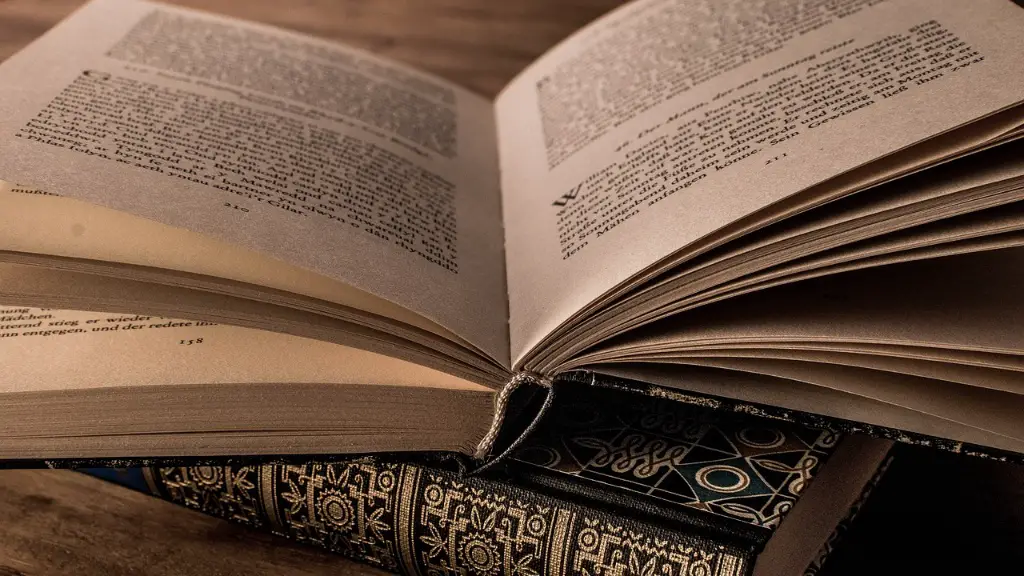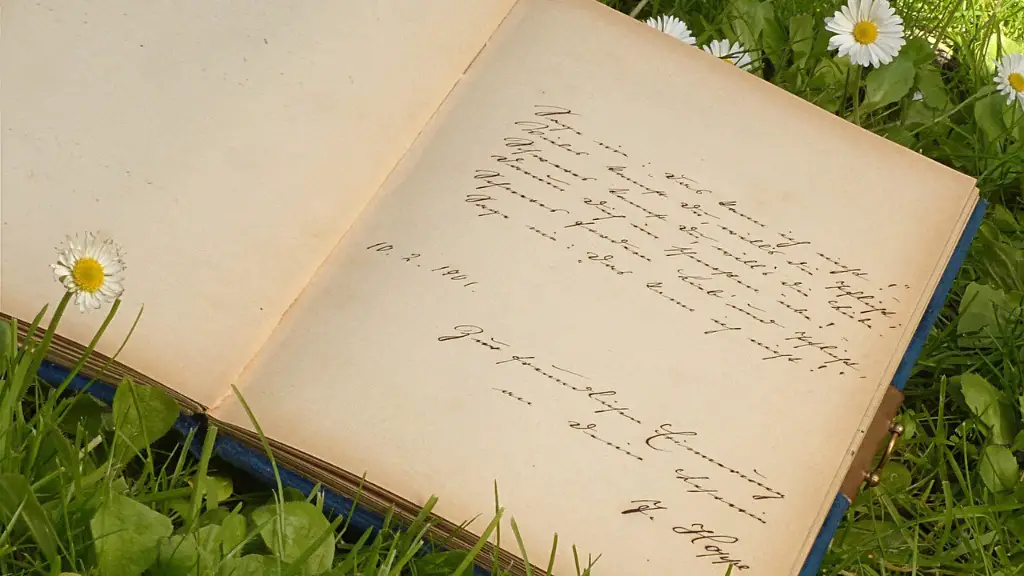Background Information
Narrative poetry is a form of poetry that tells a story, generally through a poetic device such as metaphor, allusion, imagery, or personification. The narrative structure of poetry has been used since the earliest forms of writings, providing readers with a captivating way to engage with the poetic language. This type of poetry has been used to provide insight into history, religion, mythology, and even personal experiences.
Narrative Elements
In general, narrative poetry consists of several components that serve to move readers through the story. These elements are often interchangeable, depending on the poem and its intended message. The most common elements of narrative poetry include characters, setting, dialogue, theme, and plot.
Characters refer to the people, animals, or characters that are featured in the poem. These characters may be directly or indirectly referring to others in real life, or can be completely made up. The characters shape the poem, offering readers a way to connect with the narrative.
The setting, or the environment in which the poem takes place, is also an important element of narrative poetry. The setting often provides readers with insight into the culture or beliefs of the writer, and provides a visual component to the poem as it develops.
Dialogue is also an essential element of narrative poetry, as it directly reveals the thoughts and feelings of the characters. In addition, it allows the poem to move along in an interesting manner, as the individual characters come to life. This can be especially effective when different characters are interacting, providing readers with an exciting experience.
The theme of the poem is generally revealed by the characters and the dialogue, though it can also be demonstrated through the setting or plot. A theme generally reveals the underlying message of the poem, and can be subtle or blunt, depending on the writer’s preference.
The plot is the sequence of events in a poem that are designed to move the story forward. The plot often takes readers on a journey with the characters, and can be linear or non-linear depending on the intended message.
Analysis
The elements of narrative poetry help to move readers through the story in an engaging and captivating manner. Through the characters, setting, dialogue, theme, and plot, readers are able to explore the narrative without ever having to leave the poem. This type of poetry allows readers to connect with the characters and experience the poem as if they were in the story.
In addition, narrative poetry is a powerful tool that allows writers to express complex ideas and emotions in a simple and direct way. Writers are able to combine their own personal experiences, beliefs, and ideas with the narrative structure in order to communicate their message to readers.
Finally, narrative poetry also provides readers with a way to engage with literature in a unique and meaningful way. By engaging with the characters, setting, dialogue, theme, and plot, readers are able to gain insight into the life of the writer and the story of the poem.
How Narrative Poetry Helps Teach Values
Narrative poetry is often used to teach values such as empathy, honesty, integrity, and trust. Through the characters, dialogue, and themes, readers are able to gain a deeper understanding of the values being presented. Not only are readers able to engage with the narrative, but they are also able to empathize with the characters and the story, allowing them to gain a greater appreciation for the values being discussed.
In addition, narrative poetry can be a great tool for understanding culture and different cultures. By using characters and settings from a variety of backgrounds, writers are able to explore different cultures and provide readers with an understanding of their beliefs and customs. This can be especially helpful for those looking to learn more about other cultures or those trying to gain insight into their own culture.
Finally, narrative poetry can help readers understand and appreciate complex social and political topics. By examining the characters, dialogue, and themes of a poem, readers are able to gain a better understanding of the topic at hand and how it affects others. This can be especially helpful for those looking to gain insight into the topics that are often discussed in the news or in political discourse.
Intersectionality in Narrative Poetry
Narrative poetry is often used to explore the concept of intersectionality, or the interconnectedness of different identities, beliefs, and experiences. By exploring the intersection of identities, beliefs, and experiences through the characters, dialogue, and themes, writers can provide readers with a more nuanced understanding of the complex issues of identity and respect.
For example, through the exploration of different characters, writers can provide insight into how different cultures or backgrounds intersect and how that affects the story and ultimately the poem as a whole. Through this exploration, readers can gain a greater understanding of the variety of perspectives out there and the importance of respecting and understanding different perspectives.
In addition, narrative poetry can provide insight into the intersection of social and political issues. By exploring the characters and themes, writers can provide readers with a greater understanding of how different issues intersect, such as race, class, gender, and sexuality. This type of writing allows readers to gain a better understanding of how these issues plays out in everyday life.
Looking to the Future: The Evolution of Narrative Poetry
Narrative poetry has evolved over time, as writers have explored new ways to tell stories and create engaging narratives. As new technologies, such as the internet and digital media, have become more accessible, writers have become increasingly creative in the way that they deliver their stories. Writers are now able to make use of multimedia, such as videos and audio clips, in order to create a more unique and engaging narrative.
In addition, writers are now able to utilize social media platforms in order to reach a much larger audience. This has allowed writers to share their stories with readers in a much more comprehensive and personal way. Through the use of these platforms, readers are able to get a much better understanding of the writer, their message, and the story that they are trying to tell.
Finally, as writers continue to explore and develop new technologies, they are also creating new ways to write narrative poetry. Through the use of virtual reality, augmented reality, and artificial intelligence, writers are able to create stories that are even more complex and intricate than ever before. This allows them to engage with their readers in a much more immersive and engaging way, allowing readers to experience the story as if they were right there with the characters.
Exploring Narrative Poetry With Technology
Narrative poets have been experimenting with new technologies in order to create even more engaging narratives. Through the use of virtual and augmented reality, writers are able to create an even more immersive story for readers. The use of these technologies allows readers to become even more engaged with the story, as they are able to interact with the characters and the environment in a more realistic way.
In addition, writers are also utilizing artificial intelligence in order to create more complex and engaging narratives. By using algorithms, writers are able to create stories that respond to the actions of readers in real time, allowing readers to experience a more personalized and engaging story. This type of writing allows writers to create stories that are even more captivating, as they are able to create a more individualized and unique experience for each reader.
Finally, writers are also experimenting with voice technology in order to create an even more immersive story. By incorporating voice technology into the narrative, writers are able to provide readers with a much more personal experience. The incorporation of this technology also allows for a more natural and engaging dialogue between readers and the narrative, creating a much more captivating experience.
The Impact of Narrative Poetry on Society
Narrative poetry has had an immense impact on society, as it has been used to explore a variety of topics and promote change. Through the use of characters, dialogue, and themes, writers have been able to explore sensitive topics in a meaningful way. Through the use of this type of writing, writers are able to move readers to action, leading to real change in a variety of ways.
In addition, narrative poetry has allowed writers to explore different cultures and histories. By exploring the characters, settings, and dialogue of different cultures, writers have been able to provide insight into the beliefs and customs of different cultures. Through the use of this type of writing, writers are able to help create understanding and appreciation between different cultures.
Finally, narrative poetry has also been used to explore social and political issues. By exploring these issues through the characters, dialogue, and themes, writers are able to provide readers with a greater understanding of how these issues affect different individuals and communities. This type of writing has helped to create change, as readers are able to gain a greater understanding of the complexities of social and political issues and how it affects their lives.


